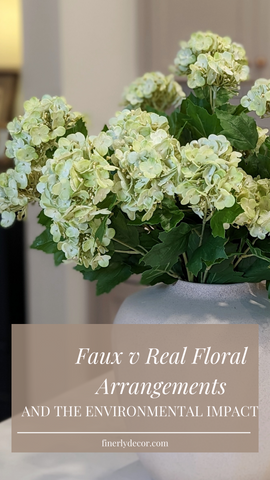Faux vs. Real Floral Home Décor: Which Is More Eco-Friendly?
Here at Finerly Decor, we believe being eco-friendly has never been more crucial than it is now. Environmental impact is a hot topic (pun intended) around the world for obvious reasons. With every purchase, more buyers are now concerned about the impact a product can have on the quality of the planet and their own lives. We get lots of questions about the environmental effects of faux versus real greenery and floral home décor environmental effects. There’s room for both, but let’s go through some key details that will help you decide when to go faux, and when to buy the real thing:

Do Flowers Play a Role in Shaping the Environment?
When it comes to home decor, most homeowners love incorporating floral arrangements and greenery into their living rooms to add an element of life and growth. In the wild, real flowers and plants obviously play an important role in shaping our environment. They grow seeds that help produce more plants that reduce carbon dioxide and generate oxygen. All things we love!

However, when it comes to décor, these flowers are cut and shipped from several foreign countries and cause more damage than you might think. Between the harvesting, packaging, energy resources to keep the flowers cool, and the enormous amount of fuel it takes to fly these flowers from foreign countries, there’s a significant negative impact.
Listen, we love TJ's flowers as much as the next gal, but we highly recommend that real florals are purchased from a local grower (find one here!) to cut down on all the negative impacts of overseas flower transport -- and bonus! You’ll be helping a small business owner in the process. Win/win!

How Is Faux Floral Home Decor Better?
Most eco-conscious people prefer purchasing faux florals for arrangements. Fake flowers do play a role in increased greenhouse emissions during production. However, compared to real flowers, they can last more than a decade longer if you take care of them. So, the impact caused by faux flowers is considered much smaller.
And while we get the concern about the packaging of faux flowers and artificial greenery, in most cases, the packaging used for them is recyclable and reusable. In the long run, faux flowers are a more sustainable and eco-friendly option than real flowers for decorations.
As an added benefit, instead of getting rare or out-of-season flowers from foreign countries and contributing to environmental effects caused by fuel, you can get fake flowers all year round in your own country. Buying fresh flowers from a grocery store leads to more toxins, emissions, and packaging than fake ones.

Final Verdict
With our experience working in the artificial floral industry, we’ve learned some things the hard way. However, we’re always ready to share our knowledge with fellow flower lovers who want to be as environmentally friendly as possible. It’s pretty clear that real flowers exported from overseas (which the vast majority of store-bought flowers are) have more negative consequences than fake flowers. Buy local and buy faux!


